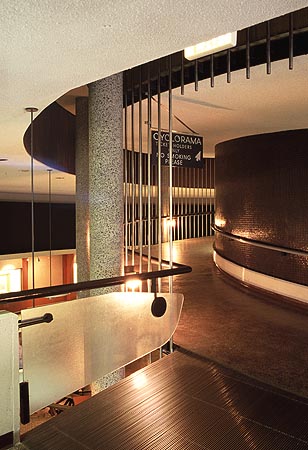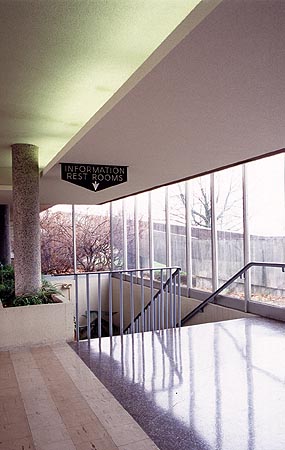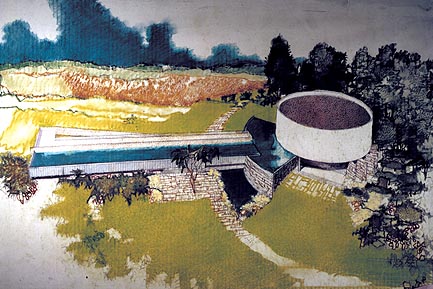
A. Photograph
by Boris Starosta, 2003.
The Cyclorama
Gallery sits atop a tiled cylinder (at right). The ramp leading
to the painting is surrounded by stainless-steel tubes; brilliant
flashes of light from the battlefield (at left) confront visitors
as they ascend the ramp. Indirect interior lighting and reflective
surfaces contribute to the quiet atmosphere of a memorial.
|

B. Photograph
by Boris Starosta, 2003.
View of
the ramp leading to the Cyclorama Gallery, illuminated by a
curving path of light, which directs visitors to the painting.
The exhibit area is visible beyond the wall of stainless-steel
tubes. The interior is remarkably intact, with virtually no
changes to the structure.
|

C. Photograph
by Boris Starosta, 2003.
The window
and auditorium walls (at perpendicular angles here) rolled back
to reveal the rolling landscapes in front of the elevated "Rostrum
of the Prophetic Voice" (behind bust of Lincoln, added
later).
|

D. Photograph
by Boris Starosta, 2003.
A "sky-bridge"
with transluscent-panel balustrades leads from the Cyclorama
Gallery ramp to the second floor lobby and out onto the rooftop
viewing platform overlooking the battlefield.
|

E. Drawing
by Neutra and Alexander for the National Park Service, 24 April
1958. Aerial View Scheme J. Courtesy National Park Service.
Neutra's
first sketches for the building show a tower between the office
wing and rotunda. This area adjacent to Zeigler's Grove was
long utilized as a viewing area for the battlefield. An Army
Corps of Engineers tower on the site, accessible only by steep
flights of stairs, was demolished during construction of the
Cyclorama Center.
|

F. Photograph
by Boris Starosta, 2003.
Second floor
lobby with concrete ramp leading to rooftop viewing platform
(outside at right).
|
|

G.
Color rendering of Cyclorama Center, ca. 1958. Courtesy National
Park Service.
|

H. Photograph
by Christine Madrid French, 1999.
View of
the battlefield from the roof of the building. General Meade's
Headquarters at center.
|

I. Photograph by Boris Starosta, 2003.
Despite
the National Park Service claims of historic landscape integrity
to be achieved with the removal of the Cyclorama Building, a
profusion of commercial establishments sits just across the
street. None of these buildings are to be removed in the Park
Service management plan.
|

J. Photograph
by Christine Madrid French, 1999.
View of
the rotunda and auditorium wall with the office wing to the
left. The concrete is ribbed and painted. Silica sand was added
to the paint to refract light.
|
 K. Photograph
by Jack Boucher, 1962, National Park Service.
K. Photograph
by Jack Boucher, 1962, National Park Service. |

L. Photograph
by Christine Madrid French, 1999.
The two-story
glass windows and second floor lobby (above and right) provided
an open view for interpretation of the battlefield in adverse
weather conditions. The automated, moveable sun louvers extended
the length of the office wing.
|
 M. Courtesy
National Park Service.
M. Courtesy
National Park Service. |
 N. Courtesy
National Park Service.
N. Courtesy
National Park Service. |
 O. Courtesy
National Park Service. Detail of this drawing is at right...
O. Courtesy
National Park Service. Detail of this drawing is at right... |
|
 P. Courtesy
National Park Service.
P. Courtesy
National Park Service. |

Q. Courtesy
National Park Service.
Bethlehem
Steel provided the cables supporting the clear-span of the Cyclorama
gallery. From Bethlehem Steel: "Neither a cable-supported
nor a cable-suspended roof structure...an 18-ft-high center
column is the hub of this hung roof. Steel purlins radiate outward
from its upper end, and bridge strands from the lower. The assemblies
are 1 3/4-in zinc-coated bridge strand, mesuring 58 ft 1 11/16
in. from center to center of pins in the attached open type
sockets. All structural steel was raised before construction
of the roof began. Then the cables were strung from the base
of the 18-ft center-column hub to connectors about the top of
the perimeter of the wall."
|

R. Photograph
by Jack Boucher, 1962, National Park Service.
Jr.
Ranger learning about Gettysburg.
|
 S. Photograph
by Jack Boucher, 1962, National Park Service.
S. Photograph
by Jack Boucher, 1962, National Park Service. |